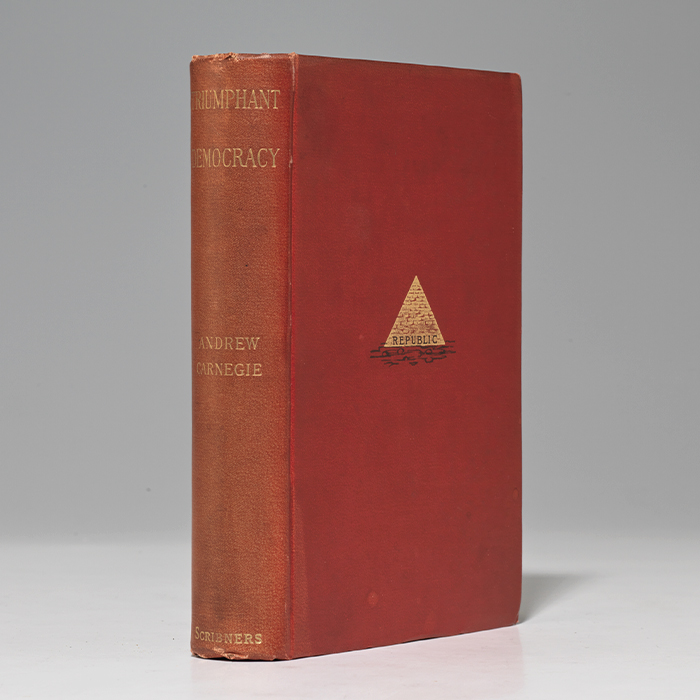
"THE CAPSTONE OF CARNEGIE'S LIFE AND WORK": TRIUMPHANT DEMOCRACY, THE WORK CARNEGIE "WOULD ALWAYS CONSIDER… HIS MAGNUM OPUS," WARMLY INSCRIBED BY HIM
CARNEGIE, Andrew. Triumphant Democracy, Or Fifty Years' March of the Republic. New York: Charles Scribner's Sons, 1891. Quarto, original gilt- and black-stamped red cloth. Housed in a custom clamshell box. $3200.
Early edition of Carnegie's defining work about American and British relations and his vision of American democracy; "whoever would try to understand Carnegie… must begin with Triumphant Democracy," an especially distinctive presentation/association copy boldly inscribed on the dedication page by him to the president of the College of Wooster, long held in high esteem by Carnegie: "Professor Holden, With regards & best wishes of Andrew Carnegie, New York Mch 31 1892."
"In 1886 America, steel was king, and Carnegie was steel. When Carnegie spoke, people listened." While he wrote essays on political issues, "he wrote only one book, Triumphant Democracy, in which he posed the American republic as a model for remaking British political institutions… His theme was patent enough. In half a century, the United States had become the most productive and affluent nation in the world… The theme was sounded clearly and blatantly on its cover, a resplendent binding in red cloth, with figures stamped in brilliant gold… There was nothing unmistakable about the meaning of the four gold figures: a solid pyramid representing the 'republic' standing firmly on its base; another pyramid representing the 'monarchy,' capsized and standing insecurely on its apex; a scepter broken in two; and a royal crown turned upside down," along with quotations by British leaders. "Never was it more clear that here was a book that could be judged by its cover… Triumphant Democracy was the capstone of Carnegie's life and work… Whoever would try to understand Carnegie, in his many achievements and ideas, must begin with Triumphant Democracy" (Eisemstadt, Carnegie's Model Republic, xi-2).
Carnegie "would always consider Triumphant Democracy his magnum opus" (ANB). This distinctive presentation/association copy of his seminal work has a fascinating history. It is inscribed by Carnegie to Louis E. Holden, president of Ohio's College of Wooster. In December 1901, after the school's Old Main was destroyed by fire, Holden "sent out telegrams to several benefactors, including steel magnate Andrew Carnegie, pleading for money in support of the University's effort to stay alive. The telegrams succinctly stated, 'Yesterday I was the president of a college. Today I am president of a hole in the ground.' The fire and subsequent ruin of Old Main was a pivotal event in the University of Wooster's history." In response, Holden "received a curious, but extremely generous proposal: if the College and town could raise $40,000 in 65 days, an unknown benefactor would give $100,000 towards rebuilding efforts. On the last day to fulfill the condition, local businesses closed and the town held a jubilee to celebrate getting enough money, although they had also envisioned the event as a last minute fundraiser, if necessary. By working together, the College and town managed to meet the required deadline to acquire the $100,000. This anonymous benefactor was not truly anonymous, because Andrew Carnegie made the proposition to President Holden in person. However, Holden was only allowed to reveal Carnegie's role if Carnegie's stipulations were achieved. Carnegie originally refused to give to a Christian college, because he was not a member of any church. Yet, even in his first meeting with Holden, Carnegie declared that if he ever gave money to a Christian college, it would go to Wooster, which eventually did come true in 1902" (College of Wooster). In addition to this inscribed copy and as a further mark of Carnegie's esteem, he personally wrote a letter to Holden in 1902 that is housed in the school's archives, praising him for his determination to save the school. Containing folding chart; with two leaves of publisher's advertisements at rear. First published in 1886. With later owner inscription; small owner inkstamp to lower fore-edge.
Inscription bold and clear, text fresh and bright, only faintest soiling to bright cloth. A handsome about-fine presentation copy.